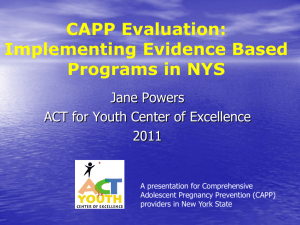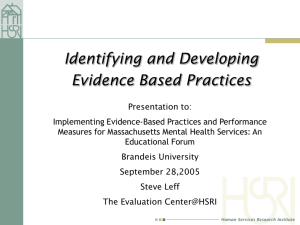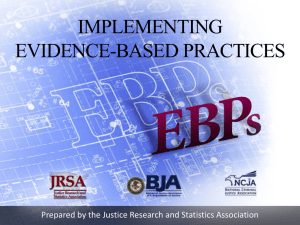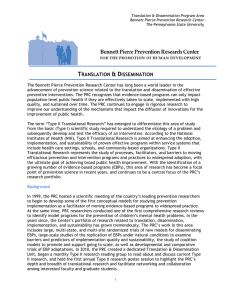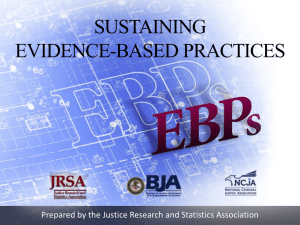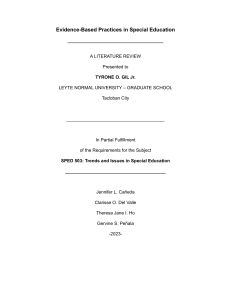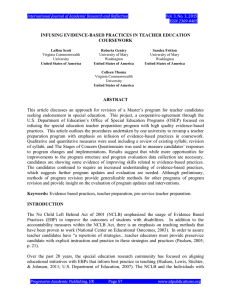E
advertisement
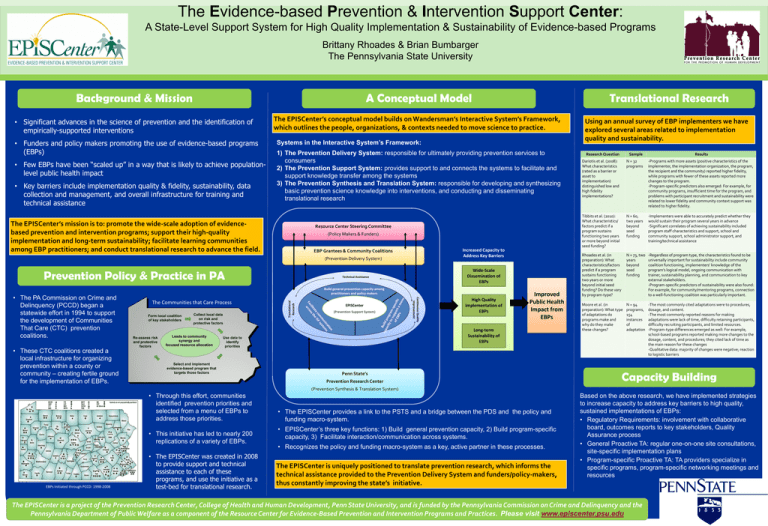
The Evidence-based Prevention & Intervention Support Center: A State-Level Support System for High Quality Implementation & Sustainability of Evidence-based Programs Brittany Rhoades & Brian Bumbarger The Pennsylvania State University Background & Mission A Conceptual Model • Significant advances in the science of prevention and the identification of empirically-supported interventions The EPISCenter’s conceptual model builds on Wandersman’s Interactive System’s Framework, which outlines the people, organizations, & contexts needed to move science to practice. • Funders and policy makers promoting the use of evidence-based programs (EBPs) • Few EBPs have been “scaled up” in a way that is likely to achieve populationlevel public health impact • Key barriers include implementation quality & fidelity, sustainability, data collection and management, and overall infrastructure for training and technical assistance Systems in the Interactive System’s Framework: 1) The Prevention Delivery System: responsible for ultimately providing prevention services to consumers 2) The Prevention Support System: provides support to and connects the systems to facilitate and support knowledge transfer among the systems 3) The Prevention Synthesis and Translation System: responsible for developing and synthesizing basic prevention science knowledge into interventions, and conducting and disseminating translational research The EPISCenter’s mission is to: promote the wide-scale adoption of evidencebased prevention and intervention programs; support their high-quality implementation and long-term sustainability; facilitate learning communities among EBP practitioners; and conduct translational research to advance the field. Resource Center Steering Committee (Policy Makers & Funders) Increased Capacity to Address Key Barriers EBP Grantees & Community Coalitions (Prevention Delivery System) Prevention Policy & Practice in PA • These CTC coalitions created a local infrastructure for organizing prevention within a county or community – creating fertile ground for the implementation of EBPs. Wide-Scale Dissemination of EBPs Technical Assistance The Communities that Care Process Form local coalition of key stakeholders Re-assess risk and protective factors Collect local data on risk and protective factors Leads to community synergy and focused resource allocation Translational Research Build general prevention capacity among practitioners and policy makers EPISCenter (Prevention Support System) High Quality Implementation of EBPs Improved Public Health Impact from EBPs Long-term Sustainability of EBPs Use data to identify priorities Select and implement evidence-based program that targets those factors Continuous Quality Improvement • The PA Commission on Crime and Delinquency (PCCD) began a statewide effort in 1994 to support the development of Communities That Care (CTC) prevention coalitions. Translational Research Penn State’s Prevention Research Center Using an annual survey of EBP implementers we have explored several areas related to implementation quality and sustainability. Research Question Sample Results Dariotis et al. (2008): What characteristics (rated as a barrier or asset to implementation) distinguished low and high fidelity implementations? N = 32 programs -Programs with more assets (positive characteristics of the implementer, the implementation organization, the program, the recipient and the community) reported higher fidelity, while programs with fewer of these assets reported more changes to the program. -Program-specific predictors also emerged: For example, for community programs, insufficient time for the program, and problems with participant recruitment and sustainability were related to lower fidelity and community context support was related to higher fidelity. Tibbits et al. (2010): What characteristics/ factors predict if a program sustains functioning two years or more beyond initial seed funding? N = 60, two years beyond seed funding -Implementers were able to accurately predict whether they would sustain their program several years in advance -Significant correlates of achieving sustainability included program staff characteristics and support, school and community support, school administrator support, and training/technical assistance Rhoades et al. (in preparation): What characteristics/factors predict if a program sustains functioning two years or more beyond initial seed funding? Do these vary by program-type? N = 73, two years beyond seed funding -Regardless of program type, the characteristics found to be universally important for sustainability include community coalition functioning, implementers’ knowledge of the program’s logical model, ongoing communication with trainer, sustainability planning, and communication to key external stakeholders. -Program-specific predictors of sustainability were also found: For example, for community/mentoring programs, connection to a well-functioning coalition was particularly important. Moore et al. (in preparation): What type of adaptations do programs make and why do they make these changes? N = 94 programs, 154 instances of adaptation -The most commonly cited adaptations were to procedures, dosage, and content. -The most commonly reported reasons for making adaptations were lack of time, difficulty retaining participants, difficulty recruiting participants, and limited resources. -Program-type differences emerged as well: For example, school-based programs reported making more changes to the dosage, content, and procedures; they cited lack of time as the main reason for these changes -Qualitative data: majority of changes were negative; reaction to logistic barriers Capacity Building (Prevention Synthesis & Translation System) • Through this effort, communities identified prevention priorities and selected from a menu of EBPs to address those priorities. • This initiative has led to nearly 200 replications of a variety of EBPs. EBPs Initiated through PCCD: 1998-2008 • The EPISCenter was created in 2008 to provide support and technical assistance to each of these programs, and use the initiative as a test-bed for translational research. • The EPISCenter provides a link to the PSTS and a bridge between the PDS and the policy and funding macro-system. • EPISCenter’s three key functions: 1) Build general prevention capacity, 2) Build program-specific capacity, 3) Facilitate interaction/communication across systems. • Recognizes the policy and funding macro-system as a key, active partner in these processes. The EPISCenter is uniquely positioned to translate prevention research, which informs the technical assistance provided to the Prevention Delivery System and funders/policy-makers, thus constantly improving the state’s initiative. Based on the above research, we have implemented strategies to increase capacity to address key barriers to high quality, sustained implementations of EBPs: • Regulatory Requirements: involvement with collaborative board, outcomes reports to key stakeholders, Quality Assurance process • General Proactive TA: regular one-on-one site consultations, site-specific implementation plans • Program-specific Proactive TA: TA providers specialize in specific programs, program-specific networking meetings and resources The EPISCenter is a project of the Prevention Research Center, College of Health and Human Development, Penn State University, and is funded by the Pennsylvania Commission on Crime and Delinquency and the Pennsylvania Department of Public Welfare as a component of the Resource Center for Evidence-Based Prevention and Intervention Programs and Practices. Please visit www.episcenter.psu.edu
